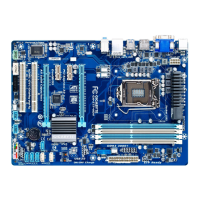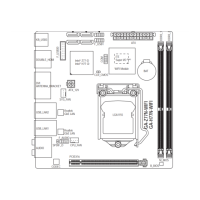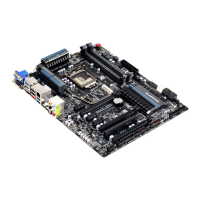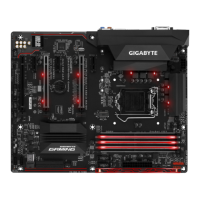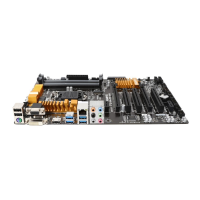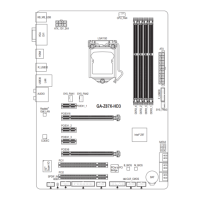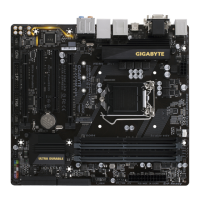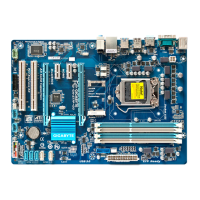
Do you have a question about the Gigabyte GA-Z77P-D3 and is the answer not in the manual?
| ECC | No |
|---|---|
| Non-ECC | Yes |
| Memory voltage | 1.5 V |
| Memory channels | Dual-channel |
| Memory slots type | DIMM |
| Number of memory slots | 4 |
| Supported memory types | DDR3-SDRAM |
| Maximum internal memory | 32 GB |
| Supported memory clock speeds | 1066, 1333, 1600 MHz |
| Supported memory module capacities | 1GB, 2GB, 4GB, 8GB |
| System bus rate | 5 GT/s |
| Processor socket | LGA 1155 (Socket H2) |
| Processor manufacturer | Intel |
| Compatible processor series | Intel Core i3, Intel Core i5, Intel Core i7 |
| Maximum number of SMP processors | 1 |
| USB 2.0 connectors | 2 |
| Number of Parallel ATA connectors | 0 |
| USB 2.0 ports quantity | USB 2.0 ports have a data transmission speed of 480 Mbps, and are backwards compatible with USB 1.1 ports. You can connect all kinds of peripheral devices to them. |
| Audio chip | Realtek ALC887 |
| Cooling type | Passive |
| Component for | PC |
| Motherboard chipset | Intel Z77 |
| PC health monitoring | CPU, FAN, Temperature |
| Audio output channels | 7.1 channels |
| Motherboard form factor | ATX |
| RAID levels | 0, 1, 5, 10 |
| Supported storage drive interfaces | SATA II, SATA III |
| Cables included | SATA |
| PCI Express slots version | 2.0, 3.0 |
| PCI Express configurations | 1x16+1x4 |
| Graphics card | HD Graphics |
| OpenGL version | 3.2 |
| DirectX version | 11 |
| Maximum graphics card memory | 1696 MB |
| Parallel processing technology support | 2-Way CrossFireX |
| LAN controller | - |
| Wi-Fi standards | Not supported |
| Networking features | 10/100/1000 Mbit/sec |
| Ethernet interface type | Gigabit Ethernet |
| BIOS type | EFI AMI |
| ACPI version | 2.0a |
| BIOS memory size | 64 Mbit |
| Depth | 215 mm |
|---|---|
| Width | 305 mm |
Lists standards for EMC directives (EN 55011, EN 61000-3-2, etc.) and LVD directives.
Declares compliance with FCC Part 15, Subpart B, Section 15.107(a) and 15.109.
Essential safety and handling guidelines prior to installing hardware components.
Detailed specifications of the motherboard's CPU, chipset, memory, expansion slots, and I/O.
Step-by-step guide for installing the CPU and CPU cooler on the motherboard.
Instructions for installing DDR3 memory modules and configuring dual-channel memory.
Procedure for installing expansion cards into PCI Express or PCI slots on the motherboard.
Explains the function and connection of various ports on the motherboard's back panel.
Details the location and function of internal connectors on the motherboard for system components.
Details the GIGABYTE logo startup screen and function keys for BIOS access.
Overview of the 3D BIOS screen and the main BIOS setup menu interface.
Section for system tuning, including CPU/memory frequency, timings, and voltage settings.
Information on CPU, motherboard model, BIOS version, system language, date, and time.
Configuration of boot order, CPU features, and device boot priorities.
Settings for integrated peripherals like SATA, USB, LAN, and Audio controllers.
Options for AC BACK, Power On By Keyboard, Resume by Alarm, and ErP power saving.
Procedures for saving changes, loading defaults, and exiting the BIOS Setup utility.
Guide to installing chipset drivers using the Xpress Install utility from the driver disk.
Lists and describes bundled GIGABYTE utilities and free software available for installation.
Provides content descriptions for the driver disk, listing included software and drivers.
Information on contacting GIGABYTE headquarters and branch offices, with website links.
Displays basic system information such as motherboard name, BIOS version, and CPU.
Links to the GIGABYTE website for downloading the latest BIOS, drivers, and applications.
Provides quick links to GIGABYTE's recently developed utilities for installation.
Utility for quick system data compression, backup, and restoration to PATA/SATA hard drives.
Explains GIGABYTE's Q-Flash and @BIOS utilities for updating the motherboard BIOS.
Tool for sharing data with other computers on the same network using LAN connection.
Utility to quickly configure RAID-ready systems and enhance drive read/write performance.
Tool to enable system power savings using a Bluetooth cell phone as a portable key.
Technology to accelerate system performance by using an SSD as a store partition for hibernation.
Allows automatic program updates via the internet while the system is suspended (sleeping).
Technology to accelerate system storage by using an SSD as a cache device for a conventional SATA disk.
Guide to configuring SATA hard drives, including RAID levels, controllers, and drivers.
Instructions for configuring 2/4/5.1/7.1-channel audio, S/PDIF out, and microphone recording.
Common troubleshooting steps, FAQs, and procedures for resolving system startup issues.

